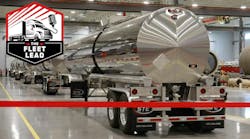Clark: Older trucks, smarter maintenance—how fleets stay ahead in a down market
Key takeaways
- Fleets are extending truck life cycles as new-equipment orders drop, making maintenance a top operational priority.
- Predictive maintenance powered by telematics helps fleets reduce downtime and avoid costly on-road breakdowns.
- Continuous training for technicians and drivers is essential to keep aging, tech-heavy trucks running efficiently.
If there were any questions about the trajectory of the industry, last week’s preliminary report from ACT Research provided some disappointing answers. According to the report, Class 8 orders are down 44% YOY, while medium-duty Classes 5-7 are down 22% YOY. OEMs are meeting this trend by scaling back production.
But freight doesn’t wait. To keep goods moving, many fleets are turning to the used truck market and forcing operators to get more out of every asset they already own. That means maintenance teams are under growing pressure to keep aging trucks running longer, safer, and more efficiently. Meeting that challenge takes more than routine upkeep. It requires a proactive, data-driven approach to maintenance.
Optimize preventive maintenance schedules to extend truck life cycles and reduce downtime
A solid preventive maintenance (PM) schedule remains the backbone of fleet reliability. Regular inspections and service intervals prevent minor issues from becoming major repairs. However, as trucks age, PM schedules can’t be a one-size-fits-all.
Fleet managers should assess maintenance intervals based on each truck’s age, mileage, climate exposure, and usage patterns. For instance, vehicles operating in colder regions face additional wear from ice, salt, and temperature extremes.
The key is consistency and flexibility. Even when a PM must be rescheduled, fleets need systems in place to track compliance and reassign service appointments promptly. Skipping maintenance isn’t an option when extending asset life cycles is the goal.
Leverage predictive maintenance and telematics to prevent costly breakdowns
Preventive maintenance is about planning; predictive maintenance is about foresight. By using real-time vehicle data and diagnostics, maintenance teams can spot potential failures before they lead to downtime. Predictive tools analyze fault codes, telematics data, and historical performance trends to identify when a part is likely to fail. This allows fleets to act early, avoiding costly breakdowns and unplanned repairs.
While implementing predictive maintenance requires the right software and analytical expertise (something that can be challenging for smaller fleets), the ROI in uptime and repair cost reduction makes it worthwhile. With the right insights, managers can prioritize issues: fixing what’s urgent, planning what can wait, and aligning everything with the next PM cycle.
Track key fleet maintenance metrics to improve performance and asset utilization
What gets measured gets managed. Fleet maintenance teams should establish key performance indicators (KPIs) to monitor efficiency and spot patterns that point to hidden problems.
Some key metrics to track include:
- Component lifespan: How many miles does each major part (e.g., tires, brakes) last before replacement?
- Between-service repairs: Do certain vehicles need attention between PM intervals? Why?
- On-road breakdown frequency: Too many incidents may indicate systemic maintenance gaps or operator issues.
- Driver inspection feedback: Daily vehicle inspection reports (DVIRs) can reveal developing issues long before diagnostics do.
When analyzed consistently, these metrics help managers identify root causes and continuously refine maintenance processes.
Strengthen technician and driver training to boost maintenance efficiency and safety
If you’re fortunate enough to have a good team, you want to retain them. With today’s vehicles packed with sensors, software, and advanced emissions systems, technicians need ongoing education to stay effective. Training programs should focus not only on diagnostic tools and repair procedures but also on technologies like AI, ADAS, and telematics integration.
Drivers, too, play a critical role as the first to notice performance changes or warning lights, serving as the fleet’s early warning system. Regular driver training builds awareness, encourages proactive reporting, and reinforces shared responsibility for keeping assets road-ready.
Transform fleet maintenance into a strategic advantage in a tightening truck market
As new-truck availability tightens and costs rise, fleets that master the art of maintaining older equipment will have a real advantage. Extending asset life cycles isn’t just about saving money; it’s about building resilience, sustainability, and operational consistency in an unpredictable market. By combining proactive maintenance, data-driven insight, and continuous training, fleets can keep older trucks performing longer and more efficiently.
About the Author
Jane Clark
Senior VP of Operations
Jane Clark is the senior vice president of operations for NationaLease. Prior to joining NationaLease, Jane served as the area vice president for Randstad, one of the nation’s largest recruitment agencies, and before that, she served in management posts with QPS Companies, Pro Staff, and Manpower, Inc.


